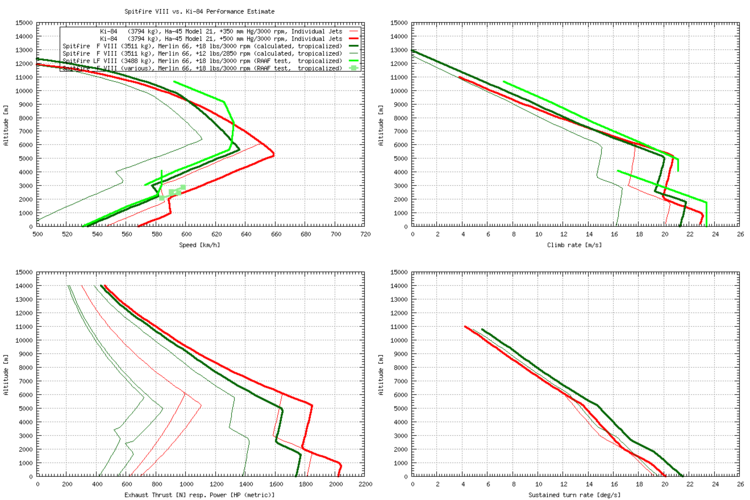Hi Spicmart,
But then again the XIV had a dual-stage supercharger. It would have needed such for the Ki-84 to feature for an apt comparison.
Thanks for providing the comparative weight data! With regard to the dual-stage supercharger, the Ki-84 might actually be competitive without one as it relied on water-methanol injection. Much as a second supercharger stage (normally, plus inter-/aftercooler), water-methanol injection was a method to improve supercharger efficiency.
Here's a comparison of two data sets for the engines (big can of worms, as there is a lot of not always conflicting data around, but these are two sets that I consider reasonbly realistic):
Engine - Griffon 65 - Ha-45 Model 21
Boost - +21 lbs/sqin - +500 mm Hg
Low Gear Full Throttle Height - 1680 m - 800 m
Low Gear Full Throttle Height Power - 2230 HP - 2040 HP
High Gear Full Throttle Height - 5700 m - 5200 m
Low Gear Full Throttle Height Power - 1860 HP - 1850 HP
(All HP values are metric to go with the metric altitudes.)
So, the Griffon 65 is better at low altitudes, and it is also better at high altitudes, but the advantage is about 10 % power down low, and +500 m altitude up high. The price the Spitfire pays for this is greater drag from the big intercoolers, but the price the Ki-84 pays for the elimination of intercooler drag is a weight increase because it has to carry a lot of methanol-water to achieve the power it has.
The Homare 45-21 (1180 mm/810 kg) had a smaller diameter than the BMW 801 (1290 mm/1012 kg) and was astoundingly light. The designers sure had to accept some drawbacks with this.
Yet the diameter of the fuselage cross section seems larger with the Japanese fighter, at least by guessing when taking a glance at profiles.
It's worth noting that the drag of streamlined bodies of a certain volume is not dominated by frontal area, and a fairly low aspect ratio actually gives the best results. This is pointed out for example by Raymer's "Simplified Aircraft Design for Homebuilders", but I believe this is also mentioned by David Lednicer in the article in which he discusses the F8F.
I suppose with radial engines, frontal area actually was of some concern for the internal aerodynamics, as even with the baffling, the internal shapes weren't streamlined. However, a well-streamlined fuselage minimizing overall drag for the aircraft might well exceed the radials frontal area and still be better than a slimmer fuselage. In fact, the Fw 190 rear fuselage had a simplified shape for ease of manufacturing ... there's an anecdote, I believe in Alfred Price' book on the Fw 190, that the original concept design of the Fw 190 had a nicely streamlined rear fuselage with a lot of compound curves, and a senior designer just took a ruler and drew straight lines on the threeview.
And a blown hood seems to have a positive effect, too.
Hm, do you mean "positive" as in "increasing drag"?
Regards,
Henning (HoHun)


